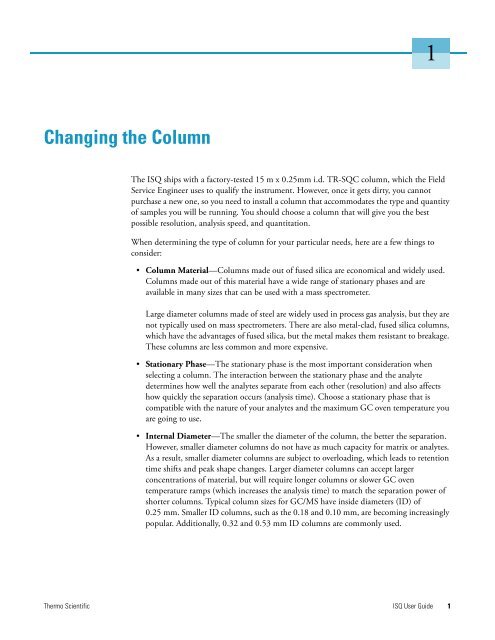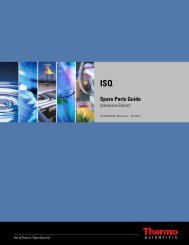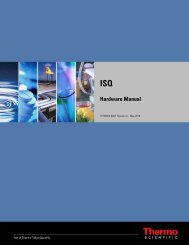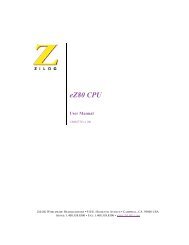ISQ User Guide - Write Frame of Mind
ISQ User Guide - Write Frame of Mind
ISQ User Guide - Write Frame of Mind
Create successful ePaper yourself
Turn your PDF publications into a flip-book with our unique Google optimized e-Paper software.
Changing the Column<br />
The <strong>ISQ</strong> ships with a factory-tested 15 m x 0.25mm i.d. TR-SQC column, which the Field<br />
Service Engineer uses to qualify the instrument. However, once it gets dirty, you cannot<br />
purchase a new one, so you need to install a column that accommodates the type and quantity<br />
<strong>of</strong> samples you will be running. You should choose a column that will give you the best<br />
possible resolution, analysis speed, and quantitation.<br />
When determining the type <strong>of</strong> column for your particular needs, here are a few things to<br />
consider:<br />
• Column Material—Columns made out <strong>of</strong> fused silica are economical and widely used.<br />
Columns made out <strong>of</strong> this material have a wide range <strong>of</strong> stationary phases and are<br />
available in many sizes that can be used with a mass spectrometer.<br />
Large diameter columns made <strong>of</strong> steel are widely used in process gas analysis, but they are<br />
not typically used on mass spectrometers. There are also metal-clad, fused silica columns,<br />
which have the advantages <strong>of</strong> fused silica, but the metal makes them resistant to breakage.<br />
These columns are less common and more expensive.<br />
• Stationary Phase—The stationary phase is the most important consideration when<br />
selecting a column. The interaction between the stationary phase and the analyte<br />
determines how well the analytes separate from each other (resolution) and also affects<br />
how quickly the separation occurs (analysis time). Choose a stationary phase that is<br />
compatible with the nature <strong>of</strong> your analytes and the maximum GC oven temperature you<br />
are going to use.<br />
• Internal Diameter—The smaller the diameter <strong>of</strong> the column, the better the separation.<br />
However, smaller diameter columns do not have as much capacity for matrix or analytes.<br />
As a result, smaller diameter columns are subject to overloading, which leads to retention<br />
time shifts and peak shape changes. Larger diameter columns can accept larger<br />
concentrations <strong>of</strong> material, but will require longer columns or slower GC oven<br />
temperature ramps (which increases the analysis time) to match the separation power <strong>of</strong><br />
shorter columns. Typical column sizes for GC/MS have inside diameters (ID) <strong>of</strong><br />
0.25 mm. Smaller ID columns, such as the 0.18 and 0.10 mm, are becoming increasingly<br />
popular. Additionally, 0.32 and 0.53 mm ID columns are commonly used.<br />
Thermo Scientific <strong>ISQ</strong> <strong>User</strong> <strong>Guide</strong> 1<br />
1






